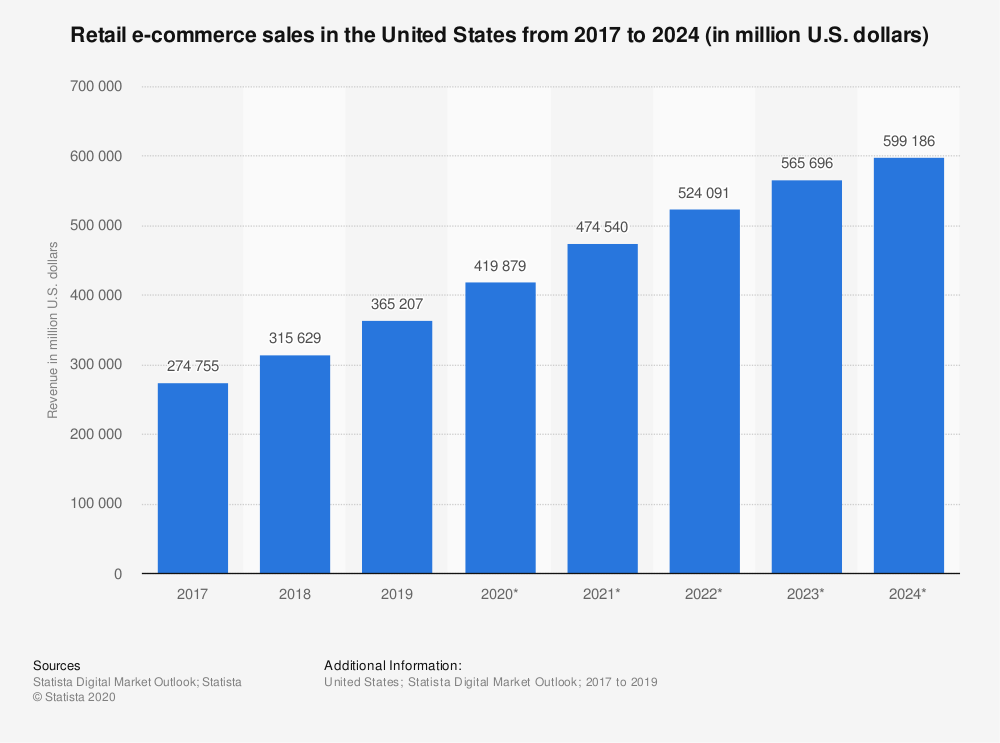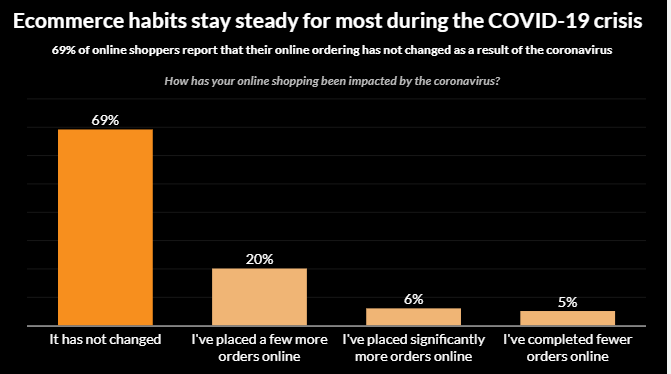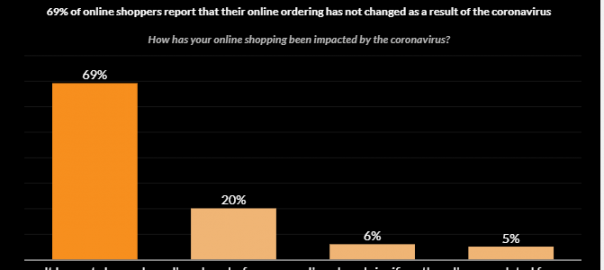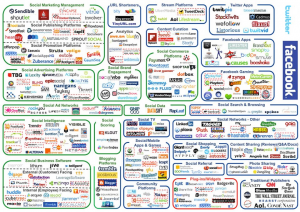As cases of Coronavirus rise worldwide, all retailers – ecommerce providers included – face an uncertain future. Consumers’ behaviours in relation to COVID-19 have changed with many people confined to the home.
No wonder the latest metrics suggest online spending has grown – some pointing to an average weekly growth in ecommerce of over 50% compared to last year.
And no surprises that the predicted winners during this crisis are the big online platforms – Amazon being a Prime Example. Their efficient inventory management system has enabled them to cope with high demand, while their emphasis on customer service has kept them ahead of the game.
Biggest Losers: Bricks & Mortar Stores
As people turn to ecommerce there’s been a simultaneous sharp decline in footfall with an estimated 30% of shoppers avoiding stores altogether. With traditional retail outlets already facing declining traffic could this latest pandemic be the final nail in the coffin?
In this post, we’ll look at how recent events have impacted the world of retail and especially that of ecommerce. Will this outbreak – like the SARS episode in China twenty years ago – cause a revolution in the way we shop?
We’ll kick off with an overview of the current situation and assess how things could play out for the ecommerce industry. We’ll then discuss the merits of becoming an omnichannel retailer especially in these uncertain times – and offer up some timely ecommerce survival tactics.
Who are The Retail Winners and Losers So Far During the COVID -19 Outbreak?
Unsurprisingly we’ve already seen some clear winners:

The giant online retail platforms including Amazon and Walmart, along with Asian ecommerce marketplaces JD, Alibaba and Taobao have seen sales rocket recently.
- Carrefour increased vegetable deliveries by 600 percent year-on-year earlier this year
- JD saw an increase of 215 percent in online grocery sales – at 15,000 tons during the first part of February this year
The Losers so far include Shopping Malls and Traditional Retail Outlets
As you’d expect there’s been a surge in online spend and a decline in revenues for traditional retail outlets. Many malls and shopping centres are like ghost towns, while a host of stores deemed ‘unessential’ have been forced to close during the outbreak.
The worry is that some traditional bricks & mortar retailers may be tipped into bankruptcy. Malls and outlets are closing because retailers simply can’t afford the rent during episodes of such low footfall.
What’s the Overall Outlook for Ecommerce?
As we know the decline in bricks and mortar footfall and increase in ecommerce is not a new trend – Coronavirus aside.
This chart from Statista illustrates the rising trend of ecommerce pre-pandemic.

Will Coronavirus Drive the Rate of Ecommerce even Faster?
We could look to history for clues to the answer to this question. This isn’t the first time retail and ecommerce have been impacted by a virus outbreak. Nearly 20 years ago the world was rocked by the SARS (Severe Acute Respiratory Syndrome) outbreak – and this had a big impact on shopper behavior overseas.
The virus spurred the growth of ecommerce in Asia, where we saw a sharp shift from selling in physical stores to selling digitally.
The SARS outbreak incentivized Chinese company JD.com to start selling predominantly online in 2004. JD is now one of the largest online sellers in China and the world. Alibaba also gained momentum in the light SARS with the decision to start selling Consumer to Consumer (C2C) online via a new platform: Taobao. Taobao currently has in the region of 60 million active sellers.
Coronavirus is far more of a global phenomenon – so the long term impact could be even greater re the momentum to move online.
Given the changing environment
What can retailers do to stay afloat amidst the Coronavirus Crisis?
Retailers need to become more customer-focused and adaptable in light of the recent crisis.
1 All Retailers Need to be Thinking ‘Omnichannel’ in Order to Survive
Most retailers are already operating a multi-channel business to cater to both on and offline consumers.
But in this current climate simply ‘having’ a variety of on and offline touchpoints isn’t enough. Ecommerce retailers need to be offering an ‘omnichannel’ experience to their customers.
That means they need to facilitate the shopping experience across all channels and put the consumer first. Retailers need to think about how to make a customer’s journey to purchase as enjoyable and seamless as possible.
The most successful brands amid the Covid-19 crisis are likely to be those that are already offering their customers an effective omnichannel retail experience. By having a strong integrated presence both offline and across online shops they’re better placed to survive declining sales in any one channel.
2 Retailers should use Online Marketplaces as Virtual Shopping Malls
Many larger retailers have a branded online store on a major online marketplace – including the likes of Amazon, eBay, Redoute, and Zalando. Marketplaces act like virtual shopping malls for brands to showcase their goods – increasing opportunities for customers to shop directly with them.
So when consumers can’t get to their bricks & mortar shops they can head here.
3 E-Retailers need to Upgrade the Customer Experience with Automation
Both traditional retailers and ecommerce companies can act to drive digitalisation further to encourage customers to interact with their brand.
From efficient inventory management to customer management systems – investing in software can help processes run more smoothly.
Increased use of automation can also help when it comes to setting up and overseeing marketing campaigns – so they run at optimum performance and achieve maximum ROIs.
If you don’t know where to start when it comes to implementing technology it could pay to read a Retail Tech Stack Report.
4 Take Google’s Advice to Ecommerce Providers regarding Coronavirus
- Keep web pages up to date with the latest information and business hours
- Clarify the precautions you’re taking with relation to staff
- Share if you’re providing extra services to help the community
- Be honest if you’re experiencing delays
- Add in COVID-19 related information to your website
It’s also an idea to ramp up your blog posting and explain if and how your products could be of help during this crisis.
As consumers can’t reach offline stores they need their questions answered online and via social media.
Act now and increase marketing activities by featuring your best selling products on the front page of your site to attract people into your online store. Remember some people may not be used to shopping online – so make it easy to buy from you. You want their first experience of buying from you to be positive so they’ll want to come back and shop again.
In Order to Survive the Coronavirus Pandemic Retailers need to Change Tactics
We live in unprecedented times and consumer behaviour is difficult to predict even when the markets are calm. To thrive in uncertain times Ecommerce retailers need to embrace change.
Recently car dealerships have been testing out their ecommerce capabilities, by reducing appointments to one on ones and leveraging their showrooms to allow for social distancing. Some are adding new services online and allowing consumers to carry out test drives at their homes and offices.
A Looming Recession Caused by Corovirus Could Also Harm Ecommerce
The flip side is that shortages in supply and reduced demand due to a possible recession could harm ecommerce over the longer term. We’re also now seeing the shutdown of ecommerce operations as a result of COVID-19 – retailer Next closing its warehouse and ceasing online deliveries along with another fashion brand TJ Maxx.
It’s not Necessarily Game Over for Bricks & Mortar Shops
And if all shopping were predicted to migrate online in the near future Amazon wouldn’t be buying up retail space in its four brick & mortar brands. And when do Amazon ever get things wrong? It also pays to remember that they’re still on track to open a significant number of full-size grocery stores.
It seems as if customers don’t see a mass exodus from physical outlets is inevitable either.
How do Customers feel Coronavirus has Impacted Shopping Habits?
Some surveys suggest the majority of consumers haven’t changed their shopping habits as much as you’d think in light of the crisis.
Somewhat surprisingly the majority said their shopping habits hadn’t changed at all – and that they weren’t making more purchases online due to the Coronavirus. Just a small number said they were buying more online – with some even stating they’d decreased their online purchases.

While many ecommerce providers are sitting on the fence about the future of retail.
How do Retailers think Coronavirus is Affecting them?
It’s a more mixed bag when it comes to retailers’ feelings. 38% believe sales will jump while the majority think sales will stay the same or even decrease during the Coronavirus outbreak.
When asked what actions they plan to take another mixed response – some retailers say they’re planning to take aggressive action, around half say they will take ‘some’ action while the rest plan to wait it out before doing anything.
For now, it’s a case of ‘wait and see’. We don’t know how long the crisis will last or how long it will take to recover. What’s for sure though is that retailers will have to put increasing effort into giving customers a consistently high quality shopping experience and consider a change in tactics to survive.
Digital & Social Articles on Business 2 Community
(25)




